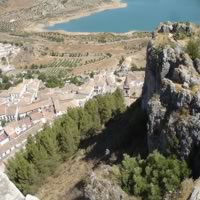EAST OF ARCOS DE LA FRONTERA

Grazalema
East of Arcos is Grazalema, another postcard-pretty hill town, offering a royal balcony for a memorable picnic, a square where you can watch old-timers playing cards, and plenty of quiet, whitewashed streets to explore. Situated within Sierra de Grazalema Natural Park, it is graced with an abundance of scenery and greenery. Driving here from Ronda on A-372, you pass through a beautiful parklike grove of cork trees. The Plaza de Andalucía, a block off the view terrace, has several decent little bars and restaurants. Shops sell the town's beautiful and famous handmade wool blankets and good-quality leather items from nearby Ubrique. While the park is known as the rainiest place in Spain, the clouds seem to wring themselves out before they reach the town.
Arcos de la Frontera - 31 miles

Setenil de las Bodegas
North of the Sierra de Grazalema is Setenil de las Bodegas, which unlike most pueblos blancos was not constructed on a hill or rocky cliff, but nestles in a network of caves in a gorge. The houses, some below rocks and others on top of or even inside the rocks, create different street levels, forming charming nooks and corners such as those in the streets Calle de las Cuevas de la Sombra and Calle de las Cuevas del Sol. The present day village has its origins in Medieval times and the area, today officially referred to as Setenil, stands on the ancient Almohad settlement. The castle overlooking the village is a Medieval fortress (14th-15th Centuries), which retains its keep and a well.
Arcos de la Frontera - 45 miles

Olvera
North of Grazalema is Olvera, worth a visit for its Moorish castle with magnificent views of surrounding hilltop villages and its nearby 'Vía Verde', a former railway line that is now a cycle path and footpath. The village's main monument is the city itself, with its whitewashed houses, steep narrow streets all running up towards the impressive silhouette of its church and castle at the top of the hill. The hills surrounding Olvera are full of olive tree plantations that provide the best extraction of olive oils in Andalusia. It's believed that the name of the town is related to the amount of olive trees in the area. There has been a human settlement on the site of Olvera for more than two thousand years. Archaeological findings suggest this verdant agricultural region northeast of Ronda was an important area for settlement as far back as the Palaeolithic era, at least twelve thousand years ago. It was definitely settled as a town during the Phoenician and Roman periods, the latter calling it either Hippa or Hippo Nova. Its first appearance in history is in the 1st century ACE History of Pliny.
Arcos de la Frontera - 41 miles
The 24 mile 'Ruta Verde,' abandoned rail-line hiking/biking route, linked to Puerto Serrano, is the result of a small, but crucial economic flip in a period of economic downturn. The shortlived dictatorship of General Rivera, between 1923-29, decided in the late 1920s, that Olvera should be the key station on a new rail link between Almargen and prosperous Jerez de la Frontera. The line was never completed, but today its leveled track bed is one of the most remarkable walking experiences in Andalucía, with half a dozen viaducts, more than twenty tunnels, two wayside restaurants and a small hotel at the Olvera terminus.

Zahara de la Sierra
A tiny town with a tingly setting under a Moorish castle has a spectacular view. During Moorish times, Zahara was contained within the fortified castle walls above today's town. It was considered the gateway to Granada and a strategic stronghold for the Moors by the Spanish Christian forces of the Reconquista.
Some 20 miles northeast of Arcos on Route A382, rounding a curve beside a pine-bordered stream, you catch a sudden white flash of Zahara through a cut in the hills. It looks magical, slightly unreal, unlikely to materialize into an actual manifestation, a White Town clinging to the upward thrust of an enormous gray rock conical rising from the plain to a pointed summit topped with an Arabic tower. The plaza is crowded, lively with bars, outdoor cafes, restaurants, shops and a lookout mirador with an encompassing view of the mountainous landscape. Well above this, the Arabic tower is available only by foot.
Arcos de la Frontera - 39 miles